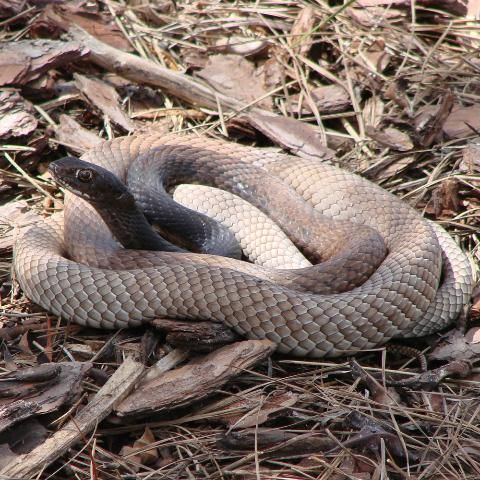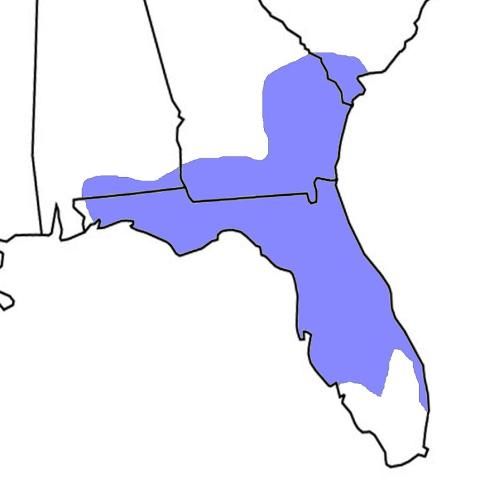Species Description
The Florida pinesnake (Pituophis melanoleucus mugitus) is one of three subspecies of pinesnakes found in the southeastern United States. One other subspecies, the black pinesnake (P. m. melanoleucus), is also found in Florida, but its range is limited to the extreme western Panhandle. Adult Florida pinesnakes are large, handsome, heavy-bodied snakes that can vary considerably in size, averaging 48–66 inches long, with the largest recorded snake reaching 90 inches (about 7 ½ feet). Adult Florida pinesnakes have a variable pattern of dark brown or rust-colored blotches on a light cream to tan background color. These markings are more distinct and vividly colored toward the tail and more indistinct or faded in appearance toward the head, which often has variable darker markings (Figure 1). Young Florida pinesnakes look much like the adults, but the dark markings are more defined (Figure 2). Throughout the southeastern US there are regional variations in the color of pinesnakes, with individuals of some populations being extremely pale, whereas others are exceptionally dark.

Credit: Gabriel Miller, University of Florida, 2008

Credit: Steve A. Johnson, University of Florida, 2008
Similar Species
The Florida pinesnake is somewhat similar in appearance to the eastern coachwhip (Coluber flagellum flagellum) and the Florida kingsnake (Lampropeltis getula floridana), which are found within the range of the Florida pinesnake. The eastern coachwhip (Figure 3) is a slender-bodied snake with a dark brown-black head that lacks blotches. The coachwhip gets its name from its long tail that looks braided, like a whip. The Florida kingsnake (Figure 4) has faint banded markings that do not become more distinct toward the tail. Both the eastern coachwhip and the Florida kingsnake have smooth scales, whereas the scales of pinesnakes have a longitudinal ridge or keel that makes them appear rough. If captured, pinesnakes can easily be identified by the large, elongated rostral scale on the nose (Figure 5), and the large, spade-shaped head—important traits that aid them in digging. The rostral scale of eastern coachwhips and Florida kingsnakes is much smaller and does not extend onto the top of the head.

Credit: Nancy West, University of Florida, 2008

Credit: Kenneth Krysko, Florida Museum of Natural History, 2008

Credit: Steve A. Johnson, University of Florida, 2007

Credit: Melissa H. Friedman, University of Florida, 2007
When approached or handled, pinesnakes may hiss loudly or may make a rattling noise by shaking their tail rapidly in dry leaves. However, although they appear menacing, pinesnakes are non-venomous and become defensive only when they feel threatened. Because of the rattling noise made by pinesnakes (and many other snakes) when threatened, and their similar coloration, the harmless Florida pinesnake is sometimes confused with the venomous eastern diamond-backed rattlesnake (Crotalus adamanteus; Figure 6). However, the eastern diamond-backed rattlesnake is much heavier-bodied, has a dark facial band and obvious dark diamond marks bordered in white down its back (Figure 6), and has a large rattle.

Credit: Steve A. Johnson, United States Geological Survey, 2003
Distribution and Habitats
Florida pinesnakes are found in the extreme Southeastern Coastal Plain of the United States, in the area from the southern tip of South Carolina west through southern Georgia and extreme southeastern Alabama, and south through most of peninsular Florida (Figure 7). Florida pinesnakes favor dry, upland areas with well-drained, sandy soils. Their preferred natural habitats include upland pine forests and sandhills (Figures 8 & 9), but they are also found in scrubby flatwoods, oak scrub, dry oak forests, old fields and agricultural borders. Unfortunately, the development and fragmentation of these native habitats for residential and commercial use have caused Florida pinesnakes to become much less common in the landscape.

Credit: Adapted from Gibbons and Dorcas (2005) by Gabriel Miller, University of Florida, 2008

Credit: Steve A. Johnson, University of Florida, 2008

Credit: Dirk Stevenson, United States Department of Defense, 2008
Behavior
Florida pinesnakes are most active in spring and early fall, and become nearly inactive during the winter months (depending on the temperature). They are most active during the day as they forage for food, seek mates, and bask in the sun. They spend the majority of their time underground in refuges, such as mammal burrows, especially those of southeastern pocket gophers, Geomys pinetis (for more information on southeastern pocket gophers, read Ecological Engineers: Pocket Gophers are one of Nature's Architects at https://edis.ifas.ufl.edu/UW285), and stump holes (channels in the soil left by the decayed roots of long-dead trees). Pinesnakes also seek refuge in the burrows of gopher tortoises. Tortoise burrows provide protection and shelter for many species of animals, ranging from large snakes like the Florida pinesnake and eastern indigo snake (for more information on indigo snakes, read 'Black Snakes': Identification and Ecology at https://edis.ifas.ufl.edu/uw251), to small invertebrates such as crickets and moths. Adept diggers, pinesnakes use their enlarged rostral scales and spade-like heads to burrow into existing underground retreats or to construct their own.
Diet
Pinesnakes are not venomous, but are powerful constrictors able to subdue a wide variety of rodent prey, including mice, cotton rats, rabbits, and pocket gophers. Pinesnakes are also known to prey on ground-nesting birds and their eggs. Pinesnakes forage for prey above and below ground, where they sometimes constrict prey by pinning them against the walls of burrows.
Reproduction
Florida pinesnakes mate in spring and the early summer; during this time, males actively seek females across large areas of suitable habitat. When a male encounters a female, he holds her by biting her neck and proceeds to entice her to mate by entwining himself around her and rubbing her body with his. The courtship and mating process can take several hours to complete. Female Florida pinesnakes lay 4–8 very large (2–4.5 in. / 4.5–12 cm long), white, leathery eggs in June or July. Eggs are typically laid in an existing underground cavity or burrow, although females have been known to excavate their own egg chamber. The eggs hatch in approximately 2 months, requiring a much longer incubation period than the eggs of most snakes. Pinesnake hatchlings are also larger than most snake hatchlings, with an average length of 15 inches.
Conservation
The Florida pinesnake is now considered uncommon over most of its range, and many herpetologists (scientists who study reptiles and amphibians) believe that this species is in decline. In Florida, the Florida pinesnake is listed as a species of special concern by the Florida Fish and Wildlife Conservation Commission. Habitat fragmentation and habitat destruction for extensive commercial and residential development and the roads that accompany development are the most significant threats to the survival of Florida pinesnakes. Since Florida pinesnakes are most active in the daytime, they are often killed crossing Florida's increasingly busy highways as they search for mates or forage for prey. Sadly, due to the common misbelief that all snakes are dangerous, people sometimes purposely run over Florida pinesnakes and many other harmless snakes. Wildlife underpasses and other improvements in road construction that reduce animal mortality have been proven to be highly effective and should be implemented in areas heavily used by wildlife or in areas where imperiled species must be protected.
In order to conserve Florida pinesnakes, we must protect large tracts of upland habitat, actively manage this land using prescribed burning, and maintain the connectivity between these habitats. Like many large snakes, Florida pinesnakes require large tracts of habitat—the home range of a male snake may be as large as 400 acres—and cannot thrive in small habitat patches. These large tracts of upland habitat must not only be preserved, but must also be actively managed using prescribed burning. Historically, Florida pinesnake habitats were maintained by fire, and the pinesnakes, along with the majority of Florida's native plant and wildlife species, have adapted to these conditions. When fire is removed or suppressed, many species disappear as the habitat gradually changes over time in the absence of fire and becomes inhospitable to these species. Therefore, fire management is essential to ensure habitat integrity for pinesnakes and many other native species. Equally critical is the need to maintain connectivity among these fire-maintained tracts of upland habitat. Connectivity allows genetic flow between populations, maintaining genetic diversity of these populations and increasing their capacity to adapt, resist disease, and persist in the landscape.
Most importantly, you can help to conserve Florida pinesnakes (and other snakes) by learning more about them and educating others. You can also help Florida scientists monitor the status of this imperiled species by reporting sightings of live or dead pine snakes at the FWC's "Rare Snake Registry" page by visiting: https://public.myfwc.com/fwri/raresnakes/. Florida's native snakes play important roles in our ecosystem, both as predators and prey. Snakes also provide a valuable service to humans, because they help regulate rodent populations that can invade our homes, become agricultural pests, or even spread disease to humans. Unfortunately, many snakes already threatened by habitat loss and road mortality are also persecuted by humans. In the US, humans kill thousands of snakes each year. Floridians must learn to respect snakes and understand the benefits they provide so that future generations will understand the importance of protecting snakes such as the Florida pinesnake.
Online Resources for More Information on Florida Pinesnakes
Dr. J's Wildlife Web Page—Online guide to Florida's Snakes: http://ufwildlife.ifas.ufl.edu/snakes/florida.shtml
Florida Museum of Natural History: http://www.flmnh.ufl.edu/herpetology/FL-GUIDE/Pituophismmugitus.htm
References and Suggested Reading
Carmichael P. and W. Williams. (1991). Florida's Fabulous Reptiles and Amphibians. California: World Publications.
Conant R. and J. T. Collins. (1998). Peterson Field Guide: A Field Guide to Reptiles and Amphibians of Eastern and Central North America, 3rd expanded ed. Boston, MA: Houghton Mifflin.
Ernst C. H. and E. M. Ernst. (2003). Snakes of the United States and Canada. Washington, D.C.: Smithsonian Books.
Franz R. (1992). "Florida pine snake, Pituophis melanoleucus mugitus Barbour," in Rare and endangered biota of Florida, Vol. III: Amphibians and reptiles, ed. P. E. Moler. Gainesville, FL: University Press of Florida. 254–58.
Franz R. (2005). "Up close and personal: a glimpse into the life of the Florida pine snake in a north Florida sand hill," in Amphibians and Reptiles: status and conservation in Florida, eds. W. E. Meshaka, Jr. and K. J. Babbitt. Malabar, FL: Krieger Publishing Co. 120–31.
Gibbons J. W. and M. E. Dorcas. (2005). Snakes of the Southeast. Athens, GA: University of Georgia Press.
Jensen J. B., C. D. Camp, J. W. Gibbons, and M. J. Elliott, eds. (1998). Amphibians and Reptiles of Georgia. Athens, GA: University of Georgia Press.
Lee D. S. (1967). "Eggs and hatchlings of the Florida pine snake, Pituophis melanoleucus mugitus," Herpetologica 23: 241–42.
Tennant A. (1997). A Field Guide to Snakes of Florida. Houston: Gulf Publishing Co.
Tuberville T. D. and P. A. Mason. (2008). "Pine Snake, Pituophis melanoleucus," in Amphibians and reptiles of Georgia, eds. J. B. Jensen, C. D. Camp, J. W. Gibbons, and M. J. Elliott. Athens, GA: University of Georgia Press. 388–90.